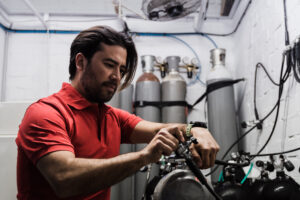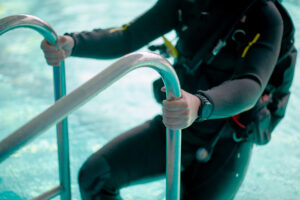What is a Purge Valve?
A purge valve is a crucial component in scuba diving equipment, designed to enhance the diver’s experience by ensuring safety and comfort underwater. This small yet essential device allows divers to expel water from their masks or regulators with ease, maintaining clear vision and a steady supply of breathable air. The functionality of purge valves significantly reduces the effort needed to clear water, making them an invaluable asset for both novice and experienced divers.
Historical Development
The evolution of scuba diving equipment has been marked by numerous innovations aimed at improving safety and functionality. The purge valve, in particular, has played a vital role in this progress. Early diving masks and regulators lacked the sophistication of modern designs, making it cumbersome for divers to clear water manually. Divers would often have to remove their masks or blow forcefully into their regulators to expel water, which could be both time-consuming and risky.
The introduction of purge valves in the mid-20th century revolutionized this aspect of diving. Initial designs were rudimentary, often consisting of simple rubber flaps or valves that allowed water to be expelled while preventing it from entering. As materials and manufacturing techniques advanced, so did the efficiency and reliability of purge valves. By the 1970s, most high-quality diving masks and regulators incorporated purge valves, providing divers with a more streamlined and safer way to clear water.
The development of the purge valve was not just about convenience but also about enhancing safety. Early divers faced significant challenges with water management, which could lead to panic or loss of orientation underwater. The advent of reliable purge valves mitigated these risks, contributing to a safer and more enjoyable diving experience. Over the decades, the design and functionality of purge valves have continued to improve, reflecting ongoing advancements in scuba diving technology.
Types of Purge Valves
Purge valves come in various designs, tailored to the specific needs of different scuba diving equipment. The most common types are those found in masks and regulators, each serving a unique purpose.
Mask purge valves are typically located at the bottom of the mask. They allow divers to expel water from the mask by simply exhaling through their nose. The expelled air pushes the water out through the valve, ensuring that the mask remains clear. This design is especially beneficial during descents and ascents when pressure changes can cause water to seep into the mask. Some masks feature a one-way valve that prevents water from re-entering, further enhancing the diver’s ability to maintain a clear field of vision.
Regulator purge valves are integral to the operation of the breathing apparatus. Located on the second stage of the regulator, these valves enable divers to clear water from the mouthpiece with a simple exhalation or by pressing a purge button. The design of regulator purge valves varies, with some featuring large, easy-to-press buttons for quick clearing. This functionality is crucial in emergency situations where maintaining a steady flow of air is vital.
Comparing these designs reveals that while the basic principle remains the same, the specific application and user interaction differ. Mask purge valves are more about maintaining visibility, while regulator purge valves are about ensuring a continuous air supply. Both types, however, are essential for a safe and enjoyable underwater experience.
Mechanism and Functionality
The functionality of a purge valve is rooted in its mechanical design. In essence, a purge valve operates as a one-way valve, allowing water to exit the system without letting it back in. This is achieved through a combination of pressure dynamics and valve construction.
In a diving mask, the purge valve is typically a small, flexible flap or diaphragm located at the lowest point. When a diver exhales through the nose, the pressure from the exhaled air forces the flap open, allowing water to be pushed out. Once the exhalation stops, the flap closes, preventing water from re-entering. This simple yet effective mechanism ensures that divers can quickly and easily clear their masks without removing them.
In regulators, the purge valve mechanism is slightly more complex. The second stage of the regulator, where the purge valve is located, is designed to deliver air to the diver while allowing for water expulsion. When the purge button is pressed, it opens a pathway that directs air from the tank through the mouthpiece, forcing any water out through the valve. This process not only clears the mouthpiece but also ensures that the diver can continue breathing without interruption. The ability to clear water quickly is crucial, especially in cold water where prolonged exposure to cold can be dangerous.
The interaction between purge valves and other scuba gear components highlights their importance. For example, the purge valve in a mask works in conjunction with the mask’s seal to ensure that water does not enter in the first place. Similarly, the regulator’s purge valve is part of a larger system that includes hoses, mouthpieces, and air tanks, all designed to work together seamlessly.
Material and Manufacturing
The materials used in the construction of purge valves are chosen for their durability, flexibility, and resistance to the harsh underwater environment. Common materials include silicone, rubber, and various plastics, each offering unique benefits.
Silicone is a popular choice due to its flexibility and resistance to degradation from saltwater and UV exposure. It is used in both mask and regulator purge valves, providing a reliable seal that can withstand repeated use. Rubber, while not as flexible as silicone, is also used for its durability and ability to maintain a seal under pressure.
The manufacturing process for purge valves involves precision molding and assembly to ensure that each valve operates correctly. The materials are shaped into the desired form, whether it be a flap, diaphragm, or button, and then integrated into the mask or regulator. Quality control is crucial, as even a small defect can compromise the valve’s performance.
Material choice and manufacturing techniques directly influence the performance and lifespan of purge valves. High-quality materials and meticulous manufacturing processes result in valves that are reliable, durable, and capable of withstanding the rigors of scuba diving. Conversely, inferior materials or poor manufacturing can lead to valve failure, which can be both inconvenient and dangerous for divers.
Maintenance and Care
Proper maintenance and care of purge valves are essential to ensure their optimal performance and longevity. Regular inspection and cleaning can prevent common issues and extend the life of the valves.
One of the best practices for maintaining purge valves is to rinse them thoroughly with fresh water after each dive. This helps to remove salt, sand, and other debris that can accumulate and cause wear or blockages. Divers should also inspect the valves for any signs of damage, such as cracks or tears, and replace them if necessary.
Common issues with purge valves include leaks, blockages, and stiffness. Leaks can occur if the valve’s seal is compromised, either due to damage or improper seating. Blockages can be caused by debris or mineral buildup, which can be cleared with gentle cleaning. Stiffness, which can make the valve difficult to operate, may result from prolonged exposure to cold temperatures or age-related wear. In such cases, replacing the valve or applying a silicone-based lubricant can restore functionality.
Storage is another important aspect of purge valve maintenance. Valves should be stored in a cool, dry place, away from direct sunlight and chemicals that could degrade the materials. Proper storage helps to prevent damage and ensures that the valves remain in good working condition.
By following these maintenance and care guidelines, divers can ensure that their purge valves function reliably, enhancing safety and comfort during their underwater activities.
Advances and Innovations
Recent years have seen significant advances in the design and functionality of purge valves, driven by ongoing research and technological innovation. These developments have focused on improving efficiency, durability, and user-friendliness.
One notable advancement is the incorporation of new materials that enhance the valve’s performance. Advanced polymers and composite materials offer superior resistance to wear and environmental factors, extending the lifespan of purge valves. These materials also allow for more precise manufacturing, resulting in valves that are more reliable and efficient.
Another area of innovation is the design of the valves themselves. Engineers are continually exploring new shapes and mechanisms that improve water expulsion and reduce the effort required by divers. For example, some modern purge valves feature multi-directional flaps or diaphragms that provide more effective clearing with minimal exhalation.
Technology is also playing a role in advancing purge valve functionality. Some high-end regulators now include electronic purge systems that automatically clear water with the push of a button. These systems use sensors and microcontrollers to detect the presence of water and activate the purge function, providing divers with an even more seamless and efficient experience.
Future trends suggest that purge valve technology will continue to evolve, with a focus on integrating smart features and enhancing compatibility with other diving equipment. As materials science and engineering techniques advance, we can expect to see purge valves that are even more robust, efficient, and user-friendly.
Key Takeaways
Purge valves are essential components in scuba diving equipment, significantly enhancing safety and comfort by allowing divers to easily clear water from masks and regulators. The historical development of purge valves reflects the broader advancements in diving technology, with modern designs offering improved efficiency and reliability. Understanding the different types, mechanisms, and materials used in purge valves is crucial for proper maintenance and care, ensuring they perform optimally. Recent innovations continue to push the boundaries of purge valve functionality, promising even greater advancements in the future.

















